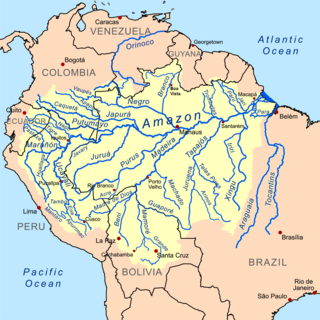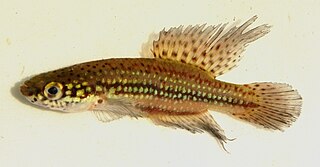
Cyprinidae is a family of freshwater fish commonly called the carp or minnow family, including the carps, the true minnows, and their relatives the barbs and barbels, among others. Cyprinidae is the largest and most diverse fish family, and the largest vertebrate animal family overall, with about 3,000 species; only 1,270 of these remain extant, divided into about 200 valid genera. Cyprinids range from about 12 mm (0.5 in) in size to the 3 m (9.8 ft) giant barb. By genus and species count, the family makes up more than two-thirds of the ostariophysian order Cypriniformes. The family name is derived from the Greek word kyprînos.

Mahseer is the common name used for the genera Tor, Neolissochilus, Naziritor and Parator in the family Cyprinidae (carps). The name is, however, more often restricted to members of the genus Tor. The range of these fish is from Vietnam in the east and China in the north, through Laos, Cambodia, Thailand, Malaysia, Brunei and Indonesia, and across southern Asia including the countries of India, Nepal, Bhutan and Bangladesh within the Indian Peninsula, plus Sri Lanka, Pakistan and Afghanistan. They are commercially important game fish, as well as highly esteemed food fish. Mahseer fetch high market price, and are potential candidate species for aquaculture. Several of the larger species have suffered severe declines, and are now considered threatened due to pollution, habitat loss, overfishing and increasing concern about the impacts of unregulated release of artificially bred stock of a very limited number of species.

Balitoridae, the hillstream loaches or river loaches, is a family, of small fish from South, Southeast and East Asia. The family includes about 202 species. They are sometimes sold as "lizardfish" or "flossensaugers". Many of the species are popular for aquaria, species in the genus Sewellia are most commonly sold in the aquaria trade. They have a number of similarities with the Cobitidae, their sibling family of "loaches", such as multiple barbels around the mouth. They should not be confused with the loricariids, which look similar but are a family of catfish.

The Amazon basin is the part of South America drained by the Amazon River and its tributaries. The Amazon drainage basin covers an area of about 7,000,000 km2 (2,700,000 sq mi), or about 35.5 percent of the South American continent. It is located in the countries of Bolivia, Brazil, Colombia, Ecuador, Guyana, Peru, Suriname, and Venezuela, as well as the territory of French Guiana.

The tench or doctor fish is a fresh- and brackish-water fish of the order Cypriniformes found throughout Eurasia from Western Europe including the British Isles east into Asia as far as the Ob and Yenisei Rivers. It is also found in Lake Baikal. It normally inhabits slow-moving freshwater habitats, particularly lakes and lowland rivers.

Neolissochilus is a genus of fish in the family Cyprinidae native to freshwater habitats in Asia that are often grouped with the mahseers. The largest reach up to 1.2 m (3.9 ft) in length, but most species are much smaller.

The black-striped squirrel is a species of rodent in the family Sciuridae. It is found throughout Java, Sumatra, southern Thailand, the Malay Peninsula, and numerous small islands. This taxon consists of four subspecies: C. n. nigrovittatus, C. n. bilimitatus, C. n. bocki, and C. n. klossi. It is listed as "least concern" by the IUCN.

Heteromormyrus is a genus of freshwater ray-finned fishes belonging to the family Mormyridae, the elephantfishes. These fishes are found in southern and central Africa in Angola, Namibia, the Democratic Republic of the Congo and, maybe, Zimbabwe.

Bangana is a genus of fish in the family Cyprinidae, the carps and minnows. It is distributed across much of southern and eastern Asia. Species live mainly in the flowing waters of tropical and subtropical rivers.
Pseudocrossocheilus is a genus of cyprinid fish endemic to China. There are currently five recognized species in this genus.

Cynopoecilus is a genus of killifish in the family Rivulidae. They are endemic to seasonal temporary pools in Southern Brazil and northeastern Uruguay. Most species are restricted to the region bordering the Patos–Mirim lagoons, but C. feltrini is found at the Tubarão River and C. intimus is found at the middle Gravataí River. The Cynopoecilus species have small ranges and are often threatened. The region inhabited by C. intimus has experienced extensive habitat destruction and recent surveys have not been able to locate this species; it may already be extinct.

The Alosidae, or the shads, are a family of clupeiform fishes. The family currently comprises four genera worldwide, and about 32 species.
Pseudocrossocheilus bamaensis is a species of freshwater ray-finned fish belonging to the family Cyprinidae, the family which includes the carps, barbs, minnows and related fishes. This fish is endemic to China where it occurs in the Hongshui River, as well as its tributary the Beipanjiang River, in Guangxi and Guizhou. Here it is found in crevices and caves in rocks emerging in the morinings and evenings to feed in the Spring and Summer, remaining in its rock shleters during the winter. This fish has a maximum published total length of 21.5 cm (8.5 in)>
Pseudocrossocheilus liuchengensis, the oil fish, is a species of freshwater ray-finned fish belonging to the family Cyprinidae, the family which includes the carps, barbs, minnows and related fishes. This species is endemic to Guangxi where it lives only in subterranean rivers.
Pseudocrossocheilus longibullus is a species of freshwater ray-finned fish belonging to the family Cyprinidae, the family which includes the carps, barbs, minnows and related fishes. This species is only known from its type locality, the Sancha River which is a tributary of the Xi River at Dongtanxiang, Libo County in Guizhou.
Pseudocrossocheilus papillolabrus is a species of freshwater ray-finned fish belonging to the family Cyprinidae. This species is found in rivers and fast flowing mountain streams in Guizhou.
Pseudocrossocheilus tridentis is a species of freshwater ray-finned fish belonging to the family Cyprinidae, the family which includes the carps, barbs, minnows and related fishes. This fish has a wide distribution in the middle and lower Nanpan River in Yunnan and Guizhou. P. tridentis is found in the lower layers of fast-flowing rivers or montane streams>
Neolissochilus nigrovittatus is a species of cyprinid in the genus Neolissochilus. It inhabits Myanmar and Thailand and has a maximum length of 13.0 centimetres (5.1 in).
Pseudochromis nigrovittatus, the blackstripe dottyback, is a species of ray-finned fish in the family Pseudochromidae. It is found in the western Indian Ocean.










